The Field Service KPI Dashboard: What Executives, Managers & Technicians Should Really Track
Mihir Joshi


Most field service organizations track KPIs - but few track them by design. Metrics often live in silos: executives focus on revenue, managers on SLA compliance, and technicians on closing tickets.
In our Field Service KPI Framework, we outlined how every service organization’s performance revolves around three dimensions - Strategic, Customer, and Operational KPIs.
This article builds on that foundation by translating those categories into role-based dashboards:
Strategic KPIs → owned by executives to steer profitability and long-term direction
Customer KPIs → tracked by managers to ensure reliability and satisfaction
Operational KPIs → managed by dispatchers and technicians to drive daily efficiency
Together, they form a single, connected performance view where strategy, experience, and execution reinforce each other. It’s also the foundation for our upcoming KPI of the Month series, starting with First Time Fix Rate (FTFR) next month.
The Hierarchy of Field Service KPIs
A well-structured KPI hierarchy ensures that every decision, from boardroom strategy to field-level execution, is guided by connected, reliable data. In high-performing service organizations, KPIs form an information cascade where insights flow top-down for direction and bottom-up for feedback.
At the strategic level, executives focus on outcomes - how service contributes to growth, profitability, and customer retention. Metrics like service revenue ratio, contract renewal rate, and customer lifetime value provide a macro view of performance and alignment with business goals. These data points define the “north star” for service transformation.
Moving down to the tactical level, service and operations managers use a blend of performance and experience KPIs, such as first-time fix rate (FTFR), mean time to repair (MTTR), SLA adherence, and CSAT/NPS. Their job is to translate strategic intent into measurable operational goals, detect patterns across teams or geographies, and act before small inefficiencies become systemic problems.
At the operational level, dispatchers and technicians deal in execution metrics. Schedule adherence, travel time, job completion rate, parts accuracy, and technician utilization indicate whether the system is functioning efficiently on the ground. This layer generates the real-time data that feeds upward, helping managers and leaders validate assumptions and refine strategy.
It also helps avoid a common pitfall: measuring activity without impact. By connecting the dots between levels, organizations move from data collection to data intelligence, where every insight leads to action and every role contributes to transformation. For a deeper view of how these layers align with strategic, customer, and operational KPIs, refer to the Field Service KPI Framework. In the below sections we cover how the KPIs stack up by role.
Executive Dashboard (VP of Service, COO, CFO)
Executives care about outcomes- profitability, growth, and brand reputation. Their KPIs must combine financial performance, customer trust, and service scalability. The visual below highlights the most critical KPIs for service and operations leaders. These executive-level metrics connect strategy with execution, measuring how effectively field service contributes to growth, profitability, and customer loyalty. Aligned with the broader KPI framework, they balance strategic, customer, and operational priorities to help leaders make informed investment and transformation decisions.
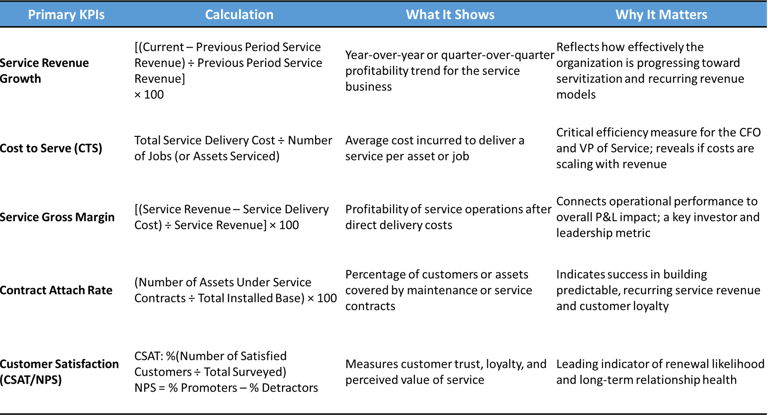

A growing service business with stable or improving margins signals sustainable performance.
Secondary KPIs: First Time Fix Rate (FTFR), SLA compliance rate, predictive maintenance accuracy (AI KPI), service backlog value.
Cost to Serve and Service Margin should ideally move in sync.
Service Manager Dashboard
Managers are the operational link between strategy and execution. They don’t just track performance but also control the levers that affect cost, efficiency, and customer experience. The visual below summarizes the key KPIs for service managers responsible for day-to-day delivery and customer experience. These metrics focus on operational efficiency, service quality, and customer outcomes. Together, they help managers translate strategic goals into measurable field performance and continuous improvement.

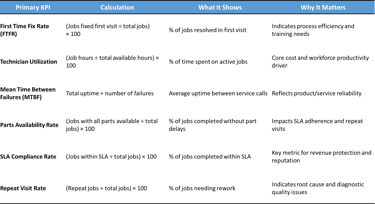
Secondary KPIs: Cost per Work Order (CPWO), Remote Resolution %, Training Hours per Technician.
Managers should use these metrics not to police performance, but to identify systemic inefficiencies such as missing parts, poor data, or outdated processes that slow technicians down.
Dispatcher & Planner Dashboard
Dispatchers are often the hidden cost controllers. They influence travel, time, and customer responsiveness -the biggest operational cost levers. The visual below outlines the essential KPIs that guide dispatchers in optimizing schedules, technician utilization, and response times. Rooted in the operational layer of the KPI framework, these metrics ensure the right job reaches the right technician at the right time while balancing resource efficiency with customer satisfaction.
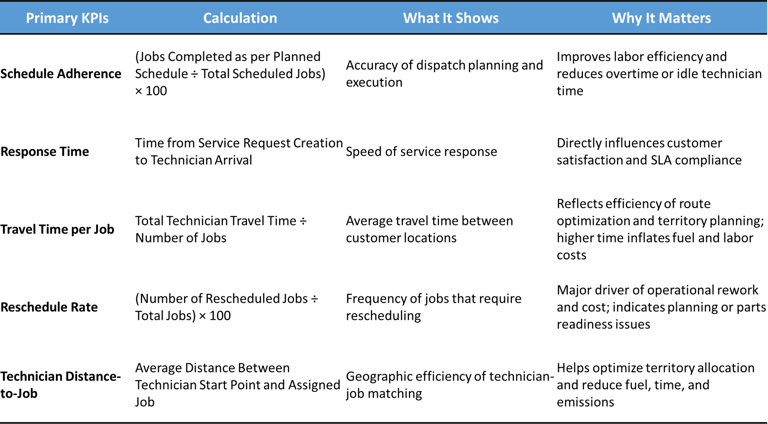

Enabling dispatchers with AI-assisted scheduling tools helps to predict best-fit technician assignments, reducing travel and improving FTFR. Even modest optimization can reduce cost-per-job by 10–15%.
Secondary KPIs: Job Acceptance Rate, Emergency Dispatch %, On time arrival rate.
Field Technician Dashboard
Technicians are the frontline value creators and their KPIs should enable, not control them. The visual below highlights the core KPIs that define technician performance and on-site service excellence. By empowering technicians with clear goals and the right data, organizations strengthen both efficiency and customer trust.
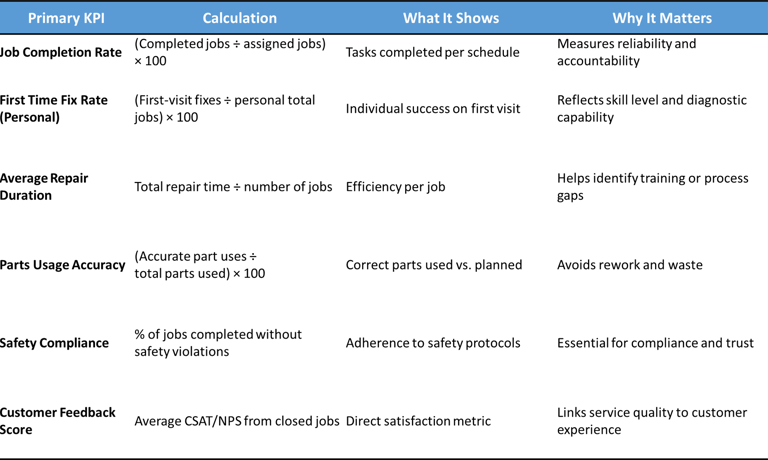

Use KPIs to equip technicians with data such as access to service history, AI-guided troubleshooting, or parts visibility, and not to micromanage performance.
When technicians feel trusted, FTFR and customer satisfaction both improve naturally.
The Emerging Layer: AI & Predictive KPIs
AI-based metrics are still nascent, but they’re shaping the future of service performance tracking. For mature organizations, these “readiness KPIs” can be monitored in parallel. These AI-driven field service KPIs help organizations assess predictive accuracy, optimization success, and data maturity, ensuring that AI not only automates, but also improves business outcomes.
Treat these as development metrics, not operational goals. Over time, they’ll become integral to the service P&L just like CTS or FTFR.
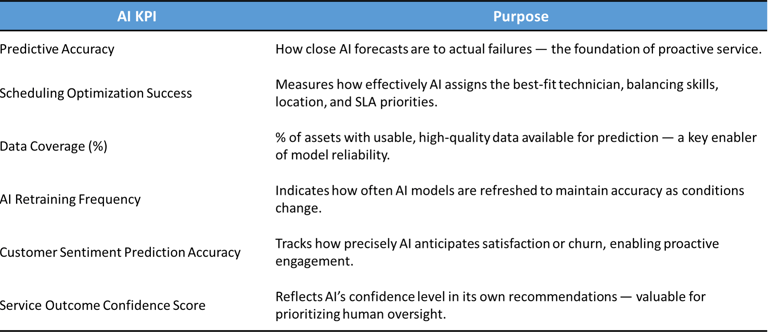

Building a Balanced Service Dashboard
To build a truly effective dashboard:
Blend financial, operational, and customer metrics, not just activity counts.
Apply a top-down visibility structure:
Executives: business outcomes
Managers: process control
Dispatchers: operational flow
Technicians: enablement and performance
Review KPIs quarterly not daily, to identify meaningful trends.
Foster transparency across roles: each team should see why their metrics matter upstream.
Building a balanced service dashboard isn’t about tracking more metrics, it’s about tracking the right ones. When every KPI tells a connected story, data becomes direction, and service teams become true growth drivers.
Stay tuned on SmartServiceOps and LinkedIn for upcoming articles in our KPI of the Month series.
Explore the Field Service KPI Framework, to learn how to design a dashboard that connects metrics, roles, and business goals, turning insights into real operational impact.
Get your Field Service KPI framework here!!
Author Info
Written by Mihir Joshi
After 15 years working with leading manufacturers, I created SmartServiceOps to share practical insights for the field service industry.
